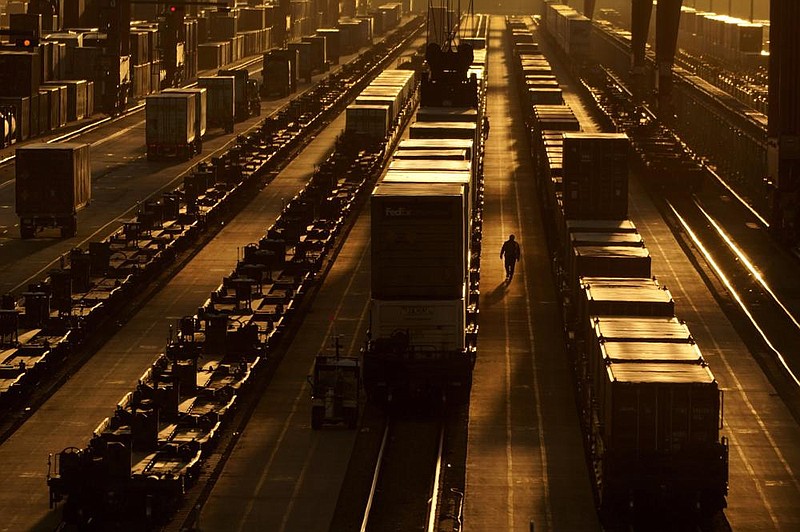WASHINGTON -- One year after the coronavirus pandemic first disrupted global supply chains by closing Chinese factories, fresh shipping headaches are delaying U.S. farm exports, crimping domestic manufacturing and threatening higher prices for American consumers.
The cost of shipping a container of goods has risen by 80% since early November and has nearly tripled over the past year, according to the Freightos Baltic Index. The increase reflects shifts in consumption during the pandemic when consumers have redirected money they once spent at restaurants or movie theaters to the purchase of record amounts of imported clothing, computers, furniture and other goods.
That abrupt and unprecedented spending shift has upended long-standing trade patterns, causing bottlenecks from the gates of Chinese factories to the doorsteps of U.S. homes.
The commercial disorder is the latest blow to globalization's finely tuned engine, capping more than a decade of financial crisis, trade wars, contagion and recession. Each shock has triggered swings in the flow of cash and goods through the $91 trillion global economy. But reverberations from the pandemic are exposing vulnerabilities in the physical plumbing of cross-border commerce that may linger, according to exporters, port officials and trade specialists.
"It's crazy. Prices are at record highs. Multiple things are happening all at once," said Phil Levy, an economist with Flexport, a San Francisco-based freight forwarder. "People work off of expectations. But now there's just so much uncertainty."
At the Port of Los Angeles one day last week, 42 ships were anchored offshore, waiting to unload their cargoes, even as every warehouse within 60 miles was already full. A shortage of dock workers amid California's worsening coronavirus outbreak is complicating operations; inbound cargo volumes in December were more than 23% higher than one year earlier.
"Some areas of the supply chain need to be sharpened," Gene Seroka, the port's executive director, said. "People are a little bit on edge."
More than one-third of the containers transiting the world's 20 largest ports last month did not ship as scheduled, according to Ocean Insights, a data provider.
The cost of imported industrial supplies jumped 4.2% in December and is up 27% since April's pandemic low, with manufacturers citing shortages of materials such as steel.
Shipping problems are affecting familiar brand names such as Gap, where an executive recently told investors that "port issues" were impeding operations. At WD-40, higher freight and warehousing costs lowered profit margins in the past quarter, Jay Rembolt, the company's chief financial officer, told investors this month. Bang & Olufsen, a maker of music systems and televisions, said it had resorted to more expensive air freight to compensate for a lack of seaborne options.
"These challenges have put inflationary cost pressures on our and many businesses and, as the market is anticipating, will put further inflationary pressure on transportation rates in 2021," Shelley Simpson, chief commercial officer for Lowell-based J.B. Hunt Transport Services, said on a recent earnings call.
Household appliances and some clothing items have been in short supply in recent months. The price of goods arriving from China posted its largest one-month gain in more than three years last month, rising by 0.3%. Overall, prices of imported goods rose 0.9%, their largest rise since August.
Average monthly import volumes in the second half of 2020 were more than 50% greater than during the first six months of the year, according to Seroka at the Port of Los Angeles.
Because there is more demand to import goods from China to the United States than to ship in the other direction, ocean carriers -- after delivering their cargoes to Los Angeles -- are refusing to wait for their containers to be reloaded with U.S. exports before returning them to China.
In December, the port processed about 2½ times as many empty containers headed to China as full ones.
"It is simply a matter of supply and demand," Seroka said.
That practice has irked American farmers, who say the shippers' refusal to bring containers into the heartland is raising their costs and causing them to lose overseas sales of soybeans, grains and lumber. A coalition of agricultural exporters wrote to Biden administration transition officials this month, citing "supply chain dysfunction" for supporting an ongoing Federal Maritime Commission probe of shippers' behavior.
The World Shipping Council, representing the cargo carriers, said the industry is doing its best. But "no part of the supply chain is geared to managing the extremes currently occurring," it said this month.
